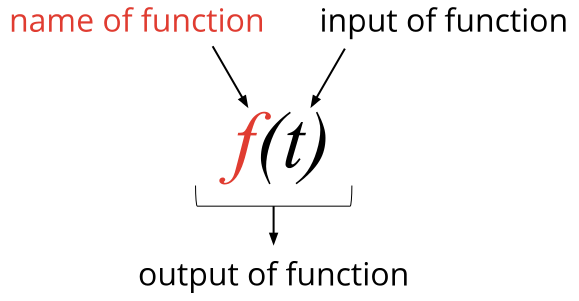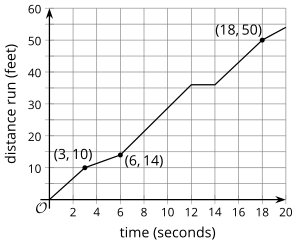Unit 4
Functions
Functions
Videos
- Video 1: Functions and Function Notation (Lessons 1–2)
- Video 2: Interpreting Function Notation (Lessons 3–5)
- Video 3: Graphs of Functions (Lessons 6–7)
- Video 4: Making and Interpreting Graphs (Lessons 8–9)
- Video 5: Domain and Range (Lessons 10–11)
- Video 6: Piecewise and Absolute Value Functions (Lessons 12–14)
- Video 7: Inverse Functions (Lessons 15–17)
Main ideas in this unit
In this unit, students learn about functions, building on their work in middle school. A function is a relationship between an input and an output, where for every input there is exactly one output. Here are some examples of functions:
- The relationship between a name (input) and the number of letters in it (output). If the input is “Maya Angelou,” the only possible output is 11.
- The relationship between the number of seconds since an oven was turned on (input) and the temperature in the oven (output). For example, 50 seconds after the oven was turned on, the temperature in the oven was 124 degrees Fahrenheit.
We often use the phrase “(output) is a function of (input)” to express how the input and output sets are related. For example, “the number of letters in a name is a function of the name,” or “the temperature in the oven is a function of time since it was turned on.”
To make it easier to talk about and work with functions, we often use letters to name them, and we use function notation to represent their input and output.
Suppose is a function that tells us the distance, in feet, that a child ran over time, , in seconds. So: is the name of the function, time is the input, and distance is the output.
Here is how we represent this information in function notation:
The notation is read “ of ”.
Here are examples of some things we can say with function notation:
| statement | meaning | interpretation |
| the output of when is the input | the distance run after seconds | |
| the output of when 3 is the input | the distance run after 3 seconds | |
| when the input is 6, the output of is 14 | in 6 seconds, the child ran 14 feet | |
| when the input is , the output of is 50 | in seconds, the child ran 50 feet |
A function can also be represented with a graph. Here is a graph of function .
We can use it to estimate the input and output values of the function.
For instance, the graph shows that , which means that 3 seconds after she started running, the child has run 10 feet.
We can also use the graph to find out the time when the child has run 50 feet, or the value of in . We can see that it happened when is 18.
Sometimes a rule tells us what to do to the input of a function to get the output.
Suppose function gives the dollar cost of buying burritos at $5 each. To get the output (the cost), we multiply the input (the number of burritos) by 5. We can write: .
Here is a task to try with your student:
The height of a plant in centimeters is a function of its height in inches, .
- Let represent this function. Name the input and output of .
- What does mean in this situation? What about ?
- Because there are 2.54 centimeters in 1 inch, a rule that defines is . What is the value of ?
- What is the value of when is 50.8?
Solution
- The input is height in inches.The output is height in centimeters.
- represents the plant’s height in centimeters when its height is 10 inches. tells us that the plant is 50.8 centimeters tall when its height is inches.
- 25.4 centimeters. ()
- 20 inches
IM Algebra 1 is copyright 2019 Illustrative Mathematics and licensed under the Creative Commons Attribution 4.0 International License (CC BY 4.0).

